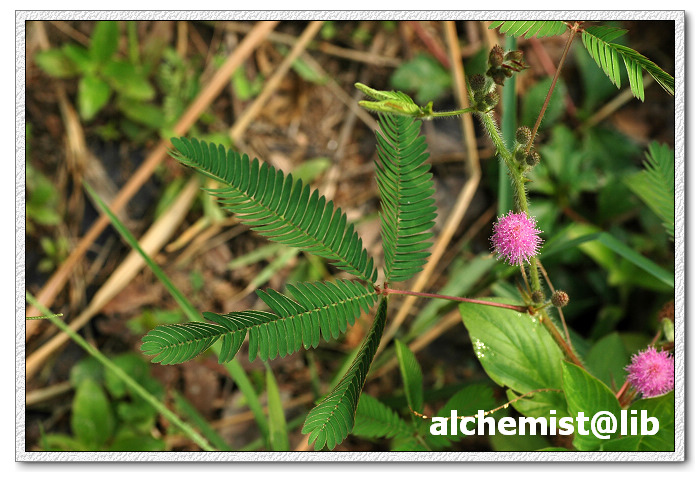- Scientific Name: Mimosa pudica L.
- Ref: Sp. Pl.:518. 1753
- Synonym: Eburnax pudica (L.) Raf.
- English Common Name: shameplant, sensitive plant, sleepy plant, action plant, Dormilones, touch-me-not, zombie plant, shy plant
- Chinese Common Name: 含羞草 hánxiū∙cǎo
- Japanese Common Name: オジギソウ [お辞儀草] ojigisō
- Family: Fabaceae
- Genus: Mimosa
- Distribution: Wilderness tracts, wastelands, or cultivated; sea level to 1500 m. Fujian, Guangdong, Guangxi, Hainan, Jiangsu, Taiwan, Yunnan, Zhejiang [native to tropical America; naturalized in tropical regions of the world].
- Photo: 06/21/2009, South China Botanical Garden, Guangdong
Herbs, diffuse, shrubby, to 1 m tall. Stems cylindric, branched, with reflexed bristles and scattered, curved prickles. Stipules lanceolate, 5-10 mm, bristly; pinnae and leaflets sensitive; pinnae usually 2 pairs, digitate, 3-8 cm; leaflets 10-20 pairs, linear-lanceolate, 6-15 × 1.5-3 mm, abaxially slightly hispid, adaxially glabrous, margin ciliate, apex acute. Heads solitary or 2, axillary, globose, ca. 1 cm in diam.; peduncle long; bracts linear. Flowers numerous, pink, small. Calyx minute. Corolla campanulate; lobes outside pubescent. Stamens 4, exserted. Ovary shortly stipitate, glabrous; ovules 3 or 4; style filiform; stigma small. Legumes arranged in a star, slightly recurved, flat, oblong, 1-2 cm × ca. 5 mm, consisting of 3-5 1-seeded segments which fall away from persistent, bristly sutures. Seeds light brown, ovoid, ca. 3.5 mm. Fl. Mar-Oct, fr. May-Nov. 2n = 52*. (Flora of China)
